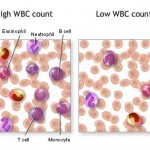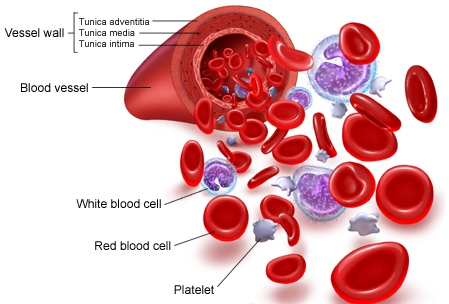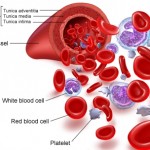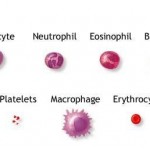A complete blood count (CBC) test measures the following:
- The number of red blood cells (RBCs)
- The number of white blood cells (WBCs)
- The total amount of hemoglobin in the blood
- The fraction of the blood composed of red blood cells (hematocrit)
The CBC test also provides information about the following measurements:
- Average red blood cell size (MCV)
- Hemoglobin amount per red blood cell (MCH)
- The amount of hemoglobin relative to the size of the cell (hemoglobin concentration) per red blood cell (MCHC)
The platelet count is also usually included in the CBC.
Why the Test is Performed
The CBC test may be performed under many different conditions and to assess many different symptoms or diseases. The results can reflect problems with fluid volume (such as dehydration) or loss of blood.
The test can reveal problems with RBC production and destruction, or help diagnose infection, allergies, and problems with blood clotting.
MCV, MCH, and MCHC values reflect the size and hemoglobin concentration of individual cells, and are useful in diagnosing different types of anemia.
Normal Results
- RBC count (varies with altitude):
- Male: 4.7 to 6.1 million cells/mcL
- Female: 4.2 to 5.4 million cells/mcL
- WBC count: 4,500 to 10,000 cells/mcL
- Hematocrit (varies with altitude):
- Male: 40.7 to 50.3%
- Female: 36.1 to 44.3%
- Hemoglobin (varies with altitude):
- Male: 13.8 to 17.2 gm/dL
- Female: 12.1 to 15.1 gm/dL
- MCV: 80 to 95 femtoliter
- MCH: 27 to 31 pg/cell
- MCHC: 32 to 36 gm/dL
(cells/mcL = cells per microliter; gm/dL = grams per deciliter; pg/cell = picograms per cell)
Note: Normal value ranges may vary slightly among different laboratories. Talk to your doctor about the meaning of your specific test results.
The examples above show the common measurements for results for these tests. Some laboratories use different measurements or may test different specimens.
What Abnormal Results Mean
High numbers of RBCs or a high hematocrit may be due to:
- Dehydration (such as from severe diarrhea)
- Kidney disease with high erythropoietin production
- Low oxygen level in the blood:
- Congenital heart disease
- Cor pulmonale
- Pulmonary fibrosis
- Polycythemia vera
- Smoking
Low numbers of RBCs or low hematocrit indicates anemia, which can result from:
- Autoimmune/collagen-vascular diseases such as lupus erythematosus or rheumatoid arthritis
- Blood loss (hemorrhage)
- Bone marrow failure (for example, from radiation, infection, or tumor)
- Erythropoietin deficiency (usually secondary to kidney disease)
- Hemolysis (red blood cell destruction)
- Leukemia
- Malnutrition (nutritional deficiencies of iron, folate, vitamin B12, or vitamin B6)
- Multiple myeloma
A lower than normal white blood cell count is called leukopenia. A decreased WBC count may be due to:
- Autoimmune/collagen-vascular diseases (such as systemic lupus erythematosus)
- Bone marrow failure (for example, due to infection, tumor, radiation, or fibrosis)
- Disease of the liver or spleen
High numbers of WBCs is called leukocytosis. It can result from:
- Infectious diseases
- Inflammatory disease (such as rheumatoid arthritis or allergy)
- Leukemia
- Severe emotional or physical stress
- Tissue damage (such as burns)
Low hemoglobin values may indicate:
- Anemia (various types)
- Blood loss
 If there is a need to only measure WBC, the blood differential test can be done, which measures the percentage of each type of white blood cell (WBC) that you have in your blood. It also reveals if there are any abnormal or immature cells.
If there is a need to only measure WBC, the blood differential test can be done, which measures the percentage of each type of white blood cell (WBC) that you have in your blood. It also reveals if there are any abnormal or immature cells.
Normal Results
- Neutrophils: 40% to 60%
- Lymphocytes: 20% to 40%
- Monocytes: 2% to 8%
- Eosinophils: 1% to 4%
- Basophils: 0.5% to 1%
- Band (young neutrophil): 0% to 3%
What Abnormal Results Mean
Any infection or acute stress increases your number of white blood cells. High white blood cell counts may be due to inflammation, an immune response, or blood diseases such as leukemia.
It is important to realize that an abnormal increase in one type of white blood cell can cause a decrease in the percentage of other types of white blood cells.
An increased percentage of neutrophils may be due to:
- Acute infection
- Acute stress
- Eclampsia
- Gout
- Myelocytic leukemia
- Rheumatoid arthritis
- Rheumatic fever
- Thyroiditis
- Trauma
A decreased percentage of neutrophils may be due to:
- Aplastic anemia
- Chemotherapy
- Influenza or other viral infection
- Widespread bacterial infection
- Radiation therapy or exposure
An increased percentage of lymphocytes may be due to:
- Chronic bacterial infection
- Infectious hepatitis
- Infectious mononucleosis
- Lymphocytic leukemia
- Multiple myeloma
- Viral infection (such as infectious mononucleosis, mumps, measles)
A decreased percentage of lymphocytes may be due to:
- Chemotherapy
- HIV infection
- Leukemia
- Radiation therapy or exposure
- Sepsis
An increased percentage of monocytes may be due to:
- Chronic inflammatory disease
- Parasitic infection
- Tuberculosis
- Viral infection (for example, infectious mononucleosis, mumps, measles)
An increased percentage of eosinophils may be due to:
- Allergic reaction
- Cancer
- Collagen vascular disease
- Parasitic infection
A decreased percentage of basophils may be due to:
- Acute allergic reaction


